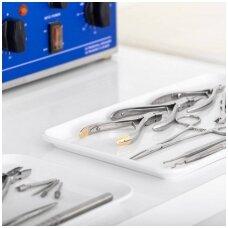Subscribe to the newsletter and be first one to know about new discounts Subscribe
What is disinfection and sterilization
-

Briefly about DISINFECTION and STERILIZATION
As old as the manicure service itself, the question about disinfection and sterilization is "what comes after what?" and "how to properly disinfect and sterilize the workplace and tools?".
Briefly, the sequence would be:
1) At the end of the service (or before each new client), it is necessary to clean up your workplace and disinfect work surfaces with biocidal means ( e.g. the most popular means ADK-611 and others ).2) Discard all disposable tools (disinfection before disposal is not necessary).
3) All reusable tools must be soaked in the prepared biocidal disinfectant solution (it is necessary to dilute the disinfectant concentrate EXACTLY according to its instructions for use and for exactly the time as written in its instructions for use). Soaking should be done in tubs resistant to chemical substances .
4) After removing the tools and the disinfectant solution after the time it was necessary to keep them there, we wash the tools under warm, running water. Do not avoid using soft brushes during washing, with their help you will clean the tools from biological residues, dust, stuck dirt. This step is necessary so that the dirt left on the tools during sterilization of the tools in the hot air sterilizer does not stick to the tools. If this happens, the sterilization will be considered failed and you will find brown spots on the tools.
5) Tools thoroughly cleaned in this way should be left to dry on a disposable towel or disposable napkin (reusable ones are not suitable). Only when the tools are completely dry can we prepare them for the sterilization procedure in the hot air sterilizer.
NOTE 1: It is necessary to make sure that the tools are completely dry, so that if the remaining moisture on the tools gets inside the envelope in which you will sterilize the tools in the hot air sterilizer, the sterilization will not take place completely and the internal indicator will not change its color. This will be considered a failure to sterilize the tools and the tools will need to be sterilized again.
NOTE 2: Composite tools such as forceps, scissors (we are talking about tools that are not homogeneous) must be sterilized when fully unfolded. This step is necessary in order to sterilize as much of the tool area as possible and to avoid covering the tool areas).
NOTE 3: Tools can be dried not only by placing them on a disposable towel . They can also be dried in a hot air sterilizer, in which case set the temperature of the sterilizer at 60-70 degrees.6) We put the disinfected, washed and dried tools in the sterilization envelope , and put the internal sterilization indicator at the same time. We seal the envelope. IMPORTANT: Do not overload the envelope. The tools should lie in the envelope so that they do not cover each other. Sterilization time is strictly not less than 60 minutes, and at a temperature not lower than 180 ° degrees. At the end of this time, both the external and internal indicators should change their original color, changing the color of the indicators is evidence that the tools have been properly sterilized.
NOTE on sterilization envelopes: instruments can be sterilized in purchased envelopes, self-made crepe paper envelopes according to the schemes specified in the hygiene law, or instruments can be sterilized without packaging.
NOTE on sterilization without envelopes: this method is only possible if after sterilizing the tools without packaging you will use them immediately. Tools sterilized in this way cannot be used 2-3 hours after such open sterilization.7) At the end of the sterilization process, mark this sterilization process in the STERILIZER WORK LOG , also open the envelope, take out the internal indicator and stick it in the log as proof that the sterilization process was carried out correctly.
NOTE: it is not mandatory to use the purchased magazine, you can print the magazine form approved by the Ministry of Health of the Republic of Lithuania. You can download it here.If you have additional questions about disinfection and sterilization, please email us at: info@salonams.eu.





